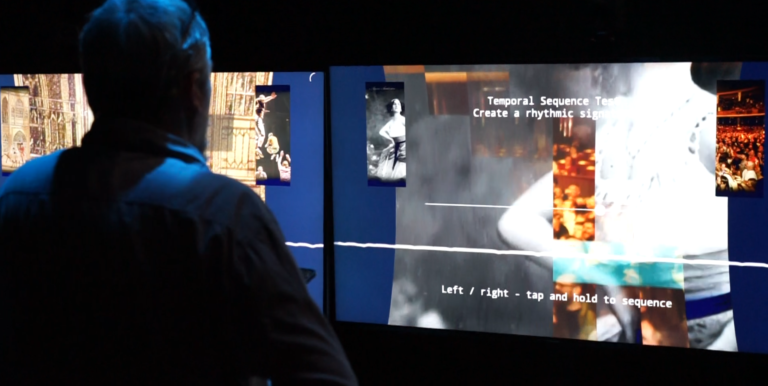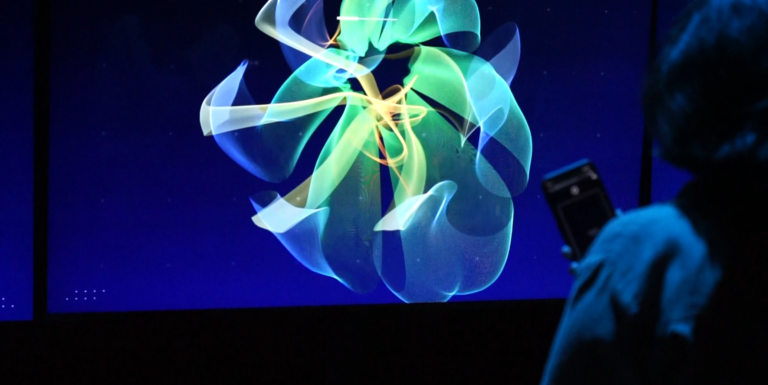In this blog, we’re exploring an emerging kind of interdisciplinary collaboration, and how similar kinds of highly iterative, agile workflow could benefit the wider creative sector. This article is less focussed on the outputs of our R&D processes, and more about how we worked together as a collective of production studios and researchers.
In late 2023, production studios OmBeond (based in London) and Ray Interactive (based in Edinburgh) joined forces to produce a new immersive installation, Electric Tapestry. Commissioned by Brighton Dome in association with Digital Catapult, we teamed up with Oliver Durcan (PhD researcher) and Dr. Peter Holland (from the University of Goldsmiths, London) to explore new kinds of movement-based audience interaction through the inspiring lens of Brighton heritage media.
As a collective, we were initially interested in using Oliver’s fascinating research into “flow states” to enhance their audience’s engagement with the piece. Flow is considered an “optimal experience” that is popularly described as being “in the zone”. In flow, interactions with present moment situations become all-encompassing, whilst irrelevant thoughts about the past, future, and self fade. It is a highly rewarding state and is often followed by motivation and wellbeing benefits.
In the experience, three guests were introduced to a fictional Artificial Intelligence called AIA. AIA appeared as a friendly, talking kaleidoscopic visualisation. After initial onboarding, guests were brought to an immersive booth consisting of three large LED screens and a surround-sound speaker array. Here, they used smartphones to engage with a selection of Brighton-inspired heritage content, with the phones and server communicating over a brand-new 5G network. The experience went far beyond scrolling and tapping, deploying sensors on the phone to translate physical motions (3D rotations, shaking, gestures) into the virtual space in real time. The aim was for users to forget that their interactions were mediated, and to feel that they could control and affect content by bodily movement alone.
A ‘passive’ audience of three watched the three participants from the back of the space.

Fig. 1: How AIA appeared to audiences.
The hypothesis was simple: the more flow active participants experience, the more meaningful their engagement with the heritage content would be.
However. No creative R&D is ever simple.
It became clear over the course of our development period that we were making a show less about ‘flow’ per se and more about how audiences can co-create, with a focus on movement – encouraged by a fictional AI premise – driving their personal decisions.

Fig 2. An active player engages with the heritage content.
Creating a meaningful, personal immersive experience with a limited library of content was a challenge. We opted to focus on form, making the interactions as smooth and intuitive as possible. At a technical level this meant minimising latency between the controller handsets and the media server, maintaining maximum frame rate, and filtering the data streams to eliminate jitter without introducing a noticeable lag. It also pushed us to find novel framings for the content: a step sequencer that made beats from mosaics of archive photographs, dreamlike journeys from present to past via generative AI, a three-dimensional ‘latent space’ of historical topics, and even a pulsing, dancing point cloud of Brighton Dome’s beautiful interior!
All too often, when creative work gets made, researchers are sent in ‘post hoc’ to perform audience surveys and then analyse the results. In this case, our creative and production team found that embedding researchers into the iterative design and production process was hugely valuable. As a result, we worked out that relatively early in the process that the show we thought we were working on was in fact different from what was working for audiences.

Fig. 3 - an audience member with their 5G ‘remote controller’ controls the visual on the screen with their movements.
So having two brilliant researchers who understood audiences, data and impact in a totally different way from us, was invaluable to the experience.
This will only strengthen our conviction that Electric Tapestry 2.0 will be even stronger for it.
Watch this space!
Thanks for reading.
Alex, Sam & Oliver.
@OmBeond (Instagram)
